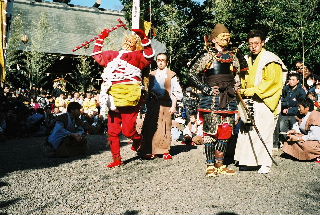 |
| photo from"Toyohashi-no-onimatsuri" |
Dengaku
 |
| photo from"Toyohashi-no-onimatsuri" |
Term used in a wide sense by contemporary scholars to refer to a variety of performing arts centering upon the production of rice. Used in a more traditional sense, the term refers to a specific type of performance, the dengaku dance, which was popular among the newly important military class in the Kamakura period (1185-1333). There were geometrically choreographed dances to the music of the flute, drum, and sasara (wooden pieces threaded together to produce a cracking sound when snapped). These dance were an important item in the repertories of certain groups of performers that were accordingly called dengaku troupes. The repertory of the dengaku, which also included acrobatics and other performances, is often mentioned along with the repertory of troupes known for another type of performance, sarugaku, as one of the antecedents of the classical noh drama. Today examples of the dengaku dance in the marrow sense can be seen performed as part of festivals and ceremonies at various shrines and temples in the Japanese coutryside. The dengaku dance itself is only one of many types of music, dance, recitation, and imitative and masked events associated with agriculture. The creation of new performance types continued even into the Edo period (1600-1868), and today there is a strong living tradition of these preserved in a multitude of festivals related to agriculture.It is to this wider tradition that the term dengaku as used by modern scholars refers. |
| from "JAPAN"Kodansha |